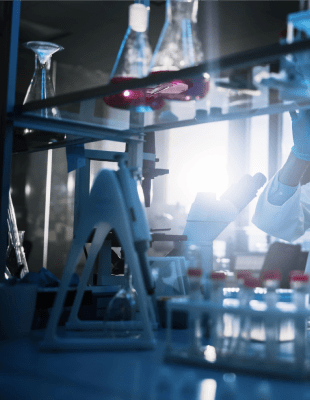The concept of prefabricated cleanroom construction is prevalent, particularly in the biopharmaceutical industry. While this type of construction is appealing due to its schedule-saving possibilities, and quality-controlled finishes, there are other considerations when choosing it instead of traditional construction.
Let’s first define what is meant by “traditional construction” and “prefabricated cleanroom construction” below:
Traditional construction: More commonly referred to as “stick-built,” it consists of typical building methodologies and materials, such as metal stud walls and ceilings clad in gypsum wallboard. This building typology has been the industry standard and the measuring stick for budget and schedule for decades.
Also included in this typology is the more recent cleanroom building trend – modular panel systems. These consist of pre-engineered “sandwich” panels with a core material lined with thin cladding material on both sides. These are used to construct walls and ceilings.
Prefabricated cleanroom construction: Prefabricated cleanroom construction is a Good Manufacturing Practice (GMP) cleanroom environment fabricated entirely off-site. The design is within the parameters of a self-supporting shell – the size of a shipping container that meets the Department of Transportation (DOT) highway shipping regulations. The GMP cleanroom environment, or “container,” is then delivered to the project site via a flatbed truck. Once onsite, the containers are then maneuvered into position and fastened together. HVAC and sometimes process skids are pre-installed during fabrication in the shop. Utility and electrical connections are made once the container reaches its intended location within an existing facility. This concept is often called “a box within a box,” and the containers are generally not entirely self-sufficient.
A common assumption regarding prefabricated cleanroom construction is that it offers a faster “speed-to-market” solution. The schedule for delivery of a prefabricated cleanroom environment tends to be quicker than that of traditional construction. Still, there are caveats, and there are also ways to improve the project schedule further. The main mitigating factor in the prefabricated cleanroom construction timeline is how well the client knows their process and process equipment requirements. Often, the pharmaceutical industry requires quickly built cleanroom environments to support the production of new vaccines and other therapies. But what if the client does not have all these answers upfront? What if the client does not have a firm handle on their process and process equipment requirements but is concerned about the project schedule? One option which could be explored early on in a project is the idea of a greenfield site versus the fit out of an existing site. Schedule savings using prefabricated cleanroom construction is typically most significant when it is a new greenfield building versus the fit out of an existing building. This is because the prefabricated cleanroom “container” can be built in parallel with the core and shell construction as opposed to a fit-out of existing space when the “core and shell” is already in place.
-
READ MORE
I have found that sometimes the desire to design and build a prefabricated cleanroom environment before the process is fully developed can become a detriment. Recently, a client worked tirelessly to scale up a product from lab to commercial scale. After developing a means that worked, they then needed the ability to mass produce the product as quickly as possible. While prefabricated cleanroom construction tends to be a great choice for this type of increase in production, it works best when the client already knows their exact process so that the environment can be efficiently engineered with limited rework. In this case, the client was developing their scale-up needs from lab to commercial scale in parallel with the design of the prefabricated environment. What was discovered was that doing both in parallel was less efficient than operating in series. Changes in the client’s production process had many impacts on the design of the prefabricated cleanroom, which at times, inhibited the fabrication of the containers. The trickle-down effect of the client’s process design changes caused a “knee-jerk” reaction in the fabrication shop, thus resulting in schedule delays and rework of the container design.
The popular opinion that prefabricated cleanroom construction is less expensive is not a blanket statement and comes with many variables. Often, these units cost more in initial investment. Costs can climb higher if the design process takes longer than anticipated due to changing needs of the client and the process. However, in traditional construction, changes are often made during construction. For prefabricated cleanroom construction to be cost-effective, the engineering design team must understand the client’s process so all utility systems, furniture, and equipment can be appropriately designed in response to the project requirements. Suppose a client has not fully developed their process and process equipment needs at the project’s onset. In that case, it isn’t easy to begin designing the prefabricated cleanroom.
Prefabricated cleanroom construction is often more expensive than stick-built construction. Still, many clients prefer it because they can start using the space sooner, thanks to a shorter build-time. According to BioProcess International, focusing on total capital investment “ignores the benefits that off-site prefabrication brings in quality, safety, construction time, and absence of hidden costs. Those factors lower risk and ultimately reduce lifecycle costs.”
Below is a breakdown of considerations for both construction typologies:
| Prefabricated cleanroom construction | Traditional |
|---|---|
| Compressed construction schedule | Long construction schedule |
| Short decision time before building begins | Changes can be made during construction |
| Fabrication is off-site in a shop, with a higher quality of construction and tolerances | Labor is on-site, typically with a lower quality of construction and tolerances |
| $$$ | $ |
| Limited post-construction modification | Easily modified post-construction |
| Small labor pool for installation on-site | Large labor pool, high labor hours. |
| Future modification to walls, doors, and fixed equipment is not easily done and is costly | Future modification of walls, doors and fixed equipment is more easily done at a cheaper cost |
Questions to ask yourself:



Prefabricated cleanroom construction can undoubtedly be a time-saving alternative to traditional construction methods if you have a firm grasp of your process and process utility requirements.




